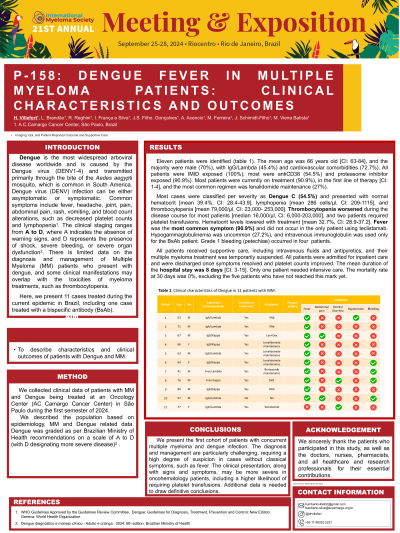Imaging, QoL and Patient-Reported Outcome and Supportive Care
Dengue fever in Multiple Myeloma patients: clinical characteristics and outcomes
P-158: Dengue fever in Multiple Myeloma patients: clinical characteristics and outcomes
Friday, September 27, 2024


Humberto Villefort, MD (he/him/his)
Hematologist
A.C.Camargo Cancer Center, Brazil
Introduction: Dengue is the most widespread arboviral disease worldwide and is caused by the Dengue virus (DENV), transmitted through vectorial infection by Aedes aegypti, a common mosquito in South America. Common symptoms include fever, headache, joint pain, abdominal pain, rash, vomiting, and blood count alterations such as decreased platelet counts and lymphopenia. There is a lack of data regarding the diagnosis and management of Multiple Myeloma (MM) patients who present with dengue and some presentations may overlap with toxicity of myeloma drugs. Here, we present 11 cases treated during the current epidemic in Brazil, including one case treated with a bispecific antibody (BsAb).
Methods: We collected clinical data of patients with MM and Dengue being treated at an Oncology Center (AC
Camargo Cancer Center) in São Paulo during the first semester of 2024. We described the population based
on epidemiology, MM related data and dengue related data. Dengue was graded as per Brazilian Ministry of Health recommendations on a scale of A to D.
Results: Eleven patients were identified. The mean age was 66 years old [CI: 63-84], and the majority were male (70%), with IgG/Lambda (45.4%) and cardiovascular comorbidities (72.7%). All patients were IMID exposed (100%); most were anti-CD38 (54.5%) and proteasome inhibitor exposed (90.9%). Most patients were currently on treatment (90.9%), in the first line of therapy [CI: 1-4], and the most common regimen was lenalidomide maintenance (27%). Most cases were classified per severity as Dengue C (54.5%) and presented with normal hematocrit [mean 39.4%, CI: 28.4-43.9], lymphopenia [mean 286 cells/μl, CI: 209-1115], and thrombocytopenia [mean 79,000/μl, CI: 23,000-253,000]. Thrombocytopenia worsened during the disease course for most patients [median 16,000/μl, CI: 6,000-203,000], and two patients required platelet transfusions. Hematocrit levels lowered with treatment [mean 32.7%, CI: 28.9-37.2]. Fever was the most common symptom (90.9%) and did not occur in the only patient using teclistamab. Hypogammaglobulinemia was uncommon (27.2%), and intravenous immunoglobulin was used only for the BsAb patient. Grade 1 bleeding (petechiae) occurred in four patients. All patients received support treatment with intravenous fluids, antipyretics and withhold of MM treatment. All patients were admitted for in-hospital stay and were discharged after resolution of symptoms and an increase in platelets. The mean duration of the hospital stay was 8 days [CI: 3-15]. Only one patient needed intensive care. The mortality rate at 30 days was 0%, excluding the five patients who have not reached this mark yet.
Conclusions: We report here the first cohort of patients with concurrent Multiple Myeloma and Dengue infection. The diagnosis and management are challenging and needs high suspicion in cases without classical symptoms such as fever. Support treatment still seems to offer good outcomes. More data is required for definitive conclusions.
Methods: We collected clinical data of patients with MM and Dengue being treated at an Oncology Center (AC
Camargo Cancer Center) in São Paulo during the first semester of 2024. We described the population based
on epidemiology, MM related data and dengue related data. Dengue was graded as per Brazilian Ministry of Health recommendations on a scale of A to D.
Results: Eleven patients were identified. The mean age was 66 years old [CI: 63-84], and the majority were male (70%), with IgG/Lambda (45.4%) and cardiovascular comorbidities (72.7%). All patients were IMID exposed (100%); most were anti-CD38 (54.5%) and proteasome inhibitor exposed (90.9%). Most patients were currently on treatment (90.9%), in the first line of therapy [CI: 1-4], and the most common regimen was lenalidomide maintenance (27%). Most cases were classified per severity as Dengue C (54.5%) and presented with normal hematocrit [mean 39.4%, CI: 28.4-43.9], lymphopenia [mean 286 cells/μl, CI: 209-1115], and thrombocytopenia [mean 79,000/μl, CI: 23,000-253,000]. Thrombocytopenia worsened during the disease course for most patients [median 16,000/μl, CI: 6,000-203,000], and two patients required platelet transfusions. Hematocrit levels lowered with treatment [mean 32.7%, CI: 28.9-37.2]. Fever was the most common symptom (90.9%) and did not occur in the only patient using teclistamab. Hypogammaglobulinemia was uncommon (27.2%), and intravenous immunoglobulin was used only for the BsAb patient. Grade 1 bleeding (petechiae) occurred in four patients. All patients received support treatment with intravenous fluids, antipyretics and withhold of MM treatment. All patients were admitted for in-hospital stay and were discharged after resolution of symptoms and an increase in platelets. The mean duration of the hospital stay was 8 days [CI: 3-15]. Only one patient needed intensive care. The mortality rate at 30 days was 0%, excluding the five patients who have not reached this mark yet.
Conclusions: We report here the first cohort of patients with concurrent Multiple Myeloma and Dengue infection. The diagnosis and management are challenging and needs high suspicion in cases without classical symptoms such as fever. Support treatment still seems to offer good outcomes. More data is required for definitive conclusions.